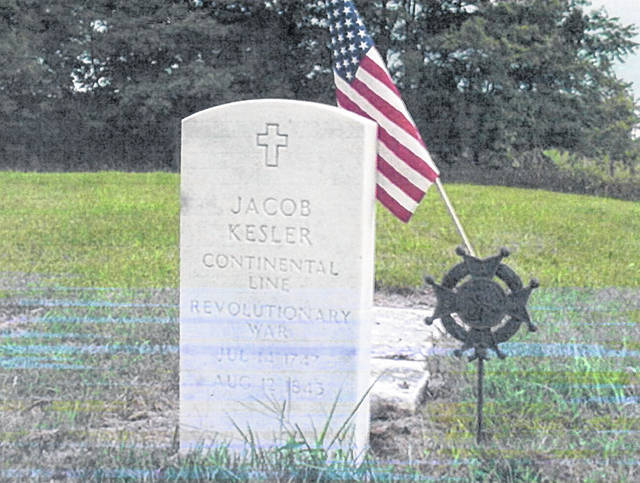
Jacob Kesler was born July 14, 1757 in Berks County, Pennsylvania. He was the son of Michael Kesler, born in Weissenback, Hessen, Germany and Anna Maria Magadalena Beck, also born in Germany. By 1775, the family was living in York County, Pennsylvania, where Jacob was drafted in the York County Militia, also know as the Continentals.
Following his tours of service, Jacob married Catherine Houser in York County in 1782. In all probability, Catherine was a widow with children. Even so, following several years of marriage and a few more children, the Kesler’s “broke up housekeeping” in Pennsylvania and moved to Virginia. They eventually settled in Rockingham County, formerly Augusta County.
The Kesler family stayed in Rockingham County until sometime in 1811 when, once again, they sold everything and moved west to Preble County, Ohio. They may have made the journey along with children, family members and friends of Henry Horn, a Revolutionary War veteran who was also from York County as well as the founder of Lewisburg, Ohio. Horn is buried in Roselawn Cemetery in Lewisburg.
Jacob Kesler and his family settled on a small farm a short distance south of Lewisburg. In addition to farming, Jacob may have been a teacher. It is believed that he taught classes in German and his son, Samuel, taught English.
Catherine Houser Kesler died on Jan. 4, 1823 in Preble County and is interred at Roselawn Cemetery. Jacob continued living at his farm until sometime after Sept. 21, 1832, when he appeared before the Honorable Judges of the Court of Common Pleas in Preble County to make declarations in order to obtain the benefit of the act of Congress passed June 7, 1832. In other words, Jacob was making a verbal application for his pension benefits. He was 75 years of age.
Jacob Kesler verbally attested to the following: he was drafted for a two-month tour of duty in 1775 or 1776. His first commander was Capt. George Deal, who was under the command of Col. Michael Swoop’s Battalion of the Pennsylvania Militia. The Battalion was marched to the State of New York near the town of Elizabeth.
At the end of the tour, Jacob reentered the Service as a volunteer, no longer a draftee, at Elizabeth/Elizabethtown for most of the tour and helped begin the construction of Fort Lee. He was discharged at Elizabeth/Elizabethtown.
Shortly afterwards, Jacob entered the Service, again as a volunteer, in Captain Nicholas Galwick’s Company of the Pennsylvania Militia under the command of Colonel Allbright in an expedition against the Indians and on to Fort Roberts. Fort Roberts’ location was in an area called Sinking Valley near what today is known as Altoona, Blair County, Pennsylvania. Fort Roberts may have also been referred to as the “Lead Mine Fort.”
Jacob served a fourth tour of duty as a substitute for a Jacob Finger from Lincoln County, North Carolina. During those three months, he became a part of the North Carolina Militia. The young private was marched to a place called Charles Town in South Carolina, today known as Charleston, under the command of Col. Frederick Hambright. Jacob spent most of his tour in Charleston. He was discharged on May 7, 1780. Five days later, the British took the town of Charleston (Siege of Charleston).
The only document that Jacob Kesler had been provided regarding his service to the new nation he fought for was a discharge paper. Over the years it had become lost. The only person that he knew of who could attest to his military service was Henry Horn, his long time friend. The two had served a tour of duty together while in the Pennsylvania Militia. Mr. Horn provided an affidavit attesting to Jacob’s service.
Mr. Frederick Miller, also a longtime friend, who was born in what was then Augusta County, Virginia, also gave a supporting affidavit. Mr. Miller too served in the military during the American Revolution as well as the War of 1812. Mr. Miller is buried in the Old Presbyterian Cemetery in New Lexington.
As time progressed, Jacob Kesler’s health declined. Eventually, it was necessary for him to move to Tippecanoe County, Indiana, in order to get the care he needed. He lived with his son George and daughter-in-law Catherine Horn Kesler (the daughter of Henry Horn). Jacob died on Aug. 12, 1843 in Tippecanoe County. In the family cemetery, now known as the Chizum Chapel Cemetery, there is a grave with two markers; one erected by family members and the second erected by the Daughters of the American Revolution.
Both stones have inscribed on them Jacob Kesler’s name, date of birth and death. Roselawn Cemetery also contains a monument that has etched on it the names of Jacob Kesler and his wife Catherine. The shared stone contains the birth and death dates of both. Indiana and Ohio both claim Jacob Kesler on official documents as being buried in their respective states! Both states want him!
Regardless of where Private Jacob Kesler is buried, we thank him for his military service. We also want to thank Jacob as well as his family for helping settle Preble County and for being a part of the creation of a new community that we can all be proud of.


